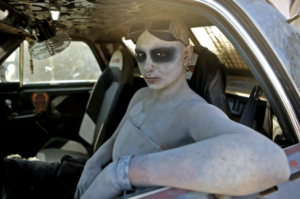Promortalism — the belief that death is always preferable to life — is one of these ideas that feels too fringe to attract much of a following. It instinctively feels more like a footnote in a philosophy class, the far end of the spectrum when talking about negative utilitarianism, for instance. Or it might come up in a discussion about E.M. Cioran, the Romanian philosopher who wrote The Trouble With Being Born, a book of aphorisms about the futility of having come into existence at all. Or it might appear in a YouTube listicle about “10 morbid subcultures you won’t believe exist”.
But as far as a real, robust community is concerned? It is too convoluted, too dark. It is the provenance of only the most depressed among us. Online spaces for the suicidal have always existed, sometimes barely euphemistically described as “sanctioned suicide”. But, surely, this philosophy runs up against the limits of its own repulsiveness?
A quick Google search suggests this is true. There is a “Daily Negativity” channel on YouTube, which publishes videos with titles such as “Is life worth living?” to just 1,000 subscribers. There is the late Jiwoon Hwang, a philosopher who wrote a paper titled “Why it is always better to cease to exist” and later took his own life. And there is a smattering of posts on obscure blogs. If more promortalists exist, they are not very open about it. But scratch the surface of another philosophy, one you have probably heard of before, and you will find that if you take their stated beliefs to their logical conclusion, the number of promortalists is higher than you’d think. They just call themselves antinatalists.
You’ve probably met an antinatalist. At the very least, you’ve read about them. If you talk to people about their choice to abstain from having children, “childfree” quickly becomes interchangeable with “antinatalism”. It’s about climate change. It’s about environmental degradation. It’s about recognising that life is suffering, and it’s time for that suffering to end with us.
In the past, a person who identified as “childfree” didn’t necessarily identify as an antinatalist: just because they didn’t have or want to have children didn’t mean they thought other people shouldn’t. Antinatalism, on the other hand, is the belief that it is morally wrong to have kids. From their perspective, life is suffering, and because nobody consented to be born, it is unethical to continue the existence of the human race. There is some possible overlap between the two, but for a long time, they were distinct — both within their respective communities and in the mainstream.
But as Amanda Sukenick, a self-described “antinatalist activist”, explained recently, these movements are increasingly becoming one and the same. This confluence means that the antinatalist community is losing some of its cohesion and philosophical bent. Looked at another way, as more people identify as “antinatalist”, as opposed to just “childfree”, it adds deeper shades of meaning to the decision not to have children.
Historically, organisations and communities geared towards the voluntarily childless did not have a cohesive philosophical or moral foundation, and they certainly didn’t proselytise. They were designed to support people who felt like they lived in a world designed for families — regardless of their reasoning. This bore out online, too. Popular hangout spots, such as the subreddit r/childfree, which today boasts 1.5 million members, and older groups, such as the LiveJournal community, were supposed to offer a place where people could commiserate. Even the more extreme community “cf_hardcore”, a LiveJournal spin-off that was more explicitly critical of “crotch goblins” — the childfree community’s charming moniker for kids — wasn’t antinatalist per se. They just didn’t like children.
Antinatalism has a more complicated history, though. While philosophers have kicked around the ethics of procreation since Thales of Miletus — and despite de-growth politics experiencing a renaissance following the publication of Paul Ehrlich’s The Population Bomb (1968), which inspired the creation of organisations such as the Voluntary Human Extinction Movement — antinatalism proper only really emerged in the mid-2000s. Antinatalism, as we know it today, was coined by philosopher David Benatar in 2006. (Around the same time, the Belgian writer Theophile Giraud also came up with a similar idea in his works, The Impertinence of Procreation and The Art of Guillotining Procreators: An anti-natalist manifesto.) For Benatar, existence is harm, and creating sentience is always morally wrong. This idea germinated in the Blogosphere among writers such as Sarah Perry, Jim Crawford, and Thomas Ligotti, but YouTube gave antinatalism its momentum.
In the mid-2000s and early-2010s, YouTube was a very different place. It was a swamp of New Atheism in its more intellectual corners, where weirdo dissidents debated one another about topics considered too controversial for the mainstream. Among those people was Kirk Neville, known online as DerivedEnergy, who, according to Sukenick, introduced antinatalism to YouTube dissidents in a two-part video called “A Defence of Anti-natalism”. YouTubers started to realise that they were antinatalists; they just hadn’t had a term for it. Response videos to DerivedEnergy began to roll in — debating him, agreeing with him — and, eventually, the antinatalism community began to coalesce.
As often happens with fringe beliefs, more extreme iterations of antinatalism also became popularised. Antinatalism led to efilism, a school of thought pioneered by Gary Mosher, known as “inmendham” on YouTube. Efilists don’t only subscribe to antinatalism but believe all life — animals included — is inherently negative. (Adam Lanza, the Sandy Hook shooter, was inspired by efilism.)
Amanda Sukenick, arguably the most significant figure in the movement, is an antinatalist and efilist. She has described how she’s had to “talk people off the ledge” of committing acts of violence; yet she’s also been recorded saying that if she knew that all suffering would “literally” end, she would endorse that happening by any means necessary. “Literally” is an important caveat — this is a thought experiment, after all — but the desire for extinction is nonetheless meaningful. And it is here that shades of promortalism start to shine through.
For some, promortalism is a different school of thought altogether. However, Jiwoon Hwang, Rafe McGregor, and Ema Sullivan-Bissett have all persuasively argued that promortalism is the core of antinatalism. In McGregor and Sullivan-Bissett’s paper “Better No Longer to Be”, they summarise their position in a single line: “[If antinatalism argues that] it is better to have never been, then it is better no longer to be.” For all three individuals, if you accept that life is suffering, it is reasonable not only to want to cease the propagation of life but to end life. Sullivan-Bissett and McGregor offer the analogy of smoking — if you think smoking causes harm, you don’t only think people shouldn’t start smoking. You believe that people should stop if they already smoke.
There are other clues, though, about antinatalism’s relationship with promortalism. To start: promortalist thinkers have been beloved in the community; Jiwoon Hwang’s death, for instance, was considered a major loss. Antinatalists are also passionate advocates of the right to die — that is, the right to commit suicide through voluntary euthanasia. Sukenick would say that she’s not unique in her enjoyment of life, but the community often speaks about how life is an imposition. When a Reddit user analysed the browsing habits of people who posted in a thread about antinatalism, he found that one of the biggest crossovers was a subreddit for people who are feeling suicidal.
They may not use the word, but it’s implicit in their online behaviours and community conversations. Life is suffering. Why continue it? The idea that life is suffering feels particularly salient for our time, especially as “doomerism” becomes increasingly mainstream. From those who are painfully, catatonically anxious about climate change or the economy to online communities who think there is nothing left to do other than to “lay down and rot” (LDAR), not only is hope for the future in short supply, but so is a shared sense that life has been worth it.
Some people laugh it off with nihilistic humour; others rebel against it by finding Christ or embracing the promise of techno-utopianism or transhumanism. But rates of loneliness, suicide and deaths of despair are all up. “Doomerism” is more than a meme word; it’s more than a hypothetical for ordinary people. And this is all kindling for the fire of promortalism to spread. The popularity of childfree-thinking and now antinatalism are not flashes in the pan. They are not signposts that we’re hedonists or too selfish to have children. They are canaries in the coal mine: for many, modern life is despair.
Disclaimer
Some of the posts we share are controversial and we do not necessarily agree with them in the whole extend. Sometimes we agree with the content or part of it but we do not agree with the narration or language. Nevertheless we find them somehow interesting, valuable and/or informative or we share them, because we strongly believe in freedom of speech, free press and journalism. We strongly encourage you to have a critical approach to all the content, do your own research and analysis to build your own opinion.
We would be glad to have your feedback.
Source: UnHerd Read the original article here: https://unherd.com/






